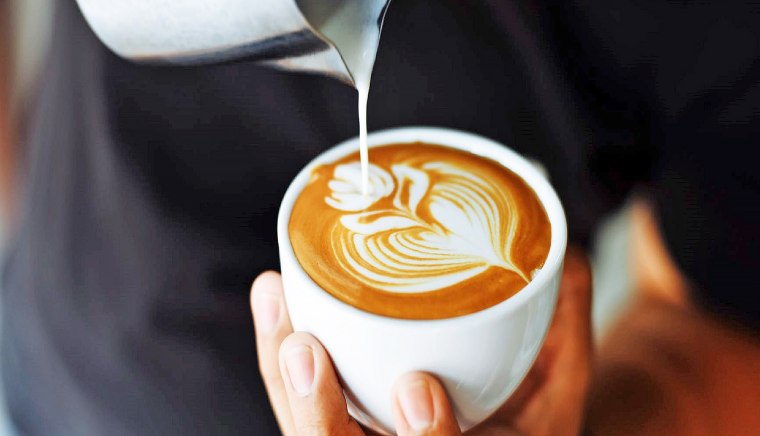Our obsession with coffee knows no bounds. Iced, espresso or a plain ol’ cup of joe gives us the caffeine boost we need to get through a trying work day. But perhaps the most beloved preparation, at least in the U.S., is the ever-so-decadent latte.
“I’m hesitant to put a formal definition to latte because coffee tends to have different meanings traditionally and regionally,” says Joe Burns, head of coffee at Pittsburgh’s Trace Brewing. “But generally speaking, lattes are larger milk-based espresso drinks for people who prefer something creamier and sweeter than regular espresso.”
While many of us rely on a Keurig, Nespresso or that smirking green siren for our morning fix, concocting a latte at home isn’t difficult. In fact, it’s downright idiot-proof. We chatted with Burns and a couple other coffee connoisseurs for their expert advice in brewing the perfect bev so you can save money while crafting something that tastes gourmet.
What is a latte?
Though interpretations of the classic latte can vary across the globe, one thing remains a constant: It’s a larger coffee drink with a lot of milk and usually a bit of a sweetness.
“There are no rules but generally a latte needs be a more milky coffee than other milk drinks (such as flat white and cappuccino) with the coffee playing a supporting role,” confirms Lavazza coffee specialist David Cutler, who trains staff on the art of coffee at Cakes & Bubbles in London’s famed Hotel Café Royal. “Originally short for the latte macchiato (milk ‘stained’ with coffee), the Italian coffee bars of the '50s would serve steamed milk in a glass with espresso poured over the top.”
“Ratios of about 1:6 parts espresso to milk with a thin layer of milk foam on top is usually where we start to call the beverage a latte,” adds Burns, though a 1:4 ratio is typically accepted as the norm in most cafes.
How to make a latte
There is a somewhat specific order of operations to consider while concocting the perfect latte. According to Burns, the first step is to brew the espresso in a mug (one or two shots, depending on the preference and/or mood) and then add any syrups or sugars directly into the espresso.
“Sugar will dissolve more easily into the hot coffee,” he notes.
Next, you’ll want to steam and/or froth your milk (quite easy to do with a handheld frother and other gadgets) and combine it with the espresso. And that’s it!
A traditional latte, at least by Italian standards, has a reverse procedure.
“A traditional Italian Latte Macchiato would be to add steamed milk into a latte glass before pouring a single espresso over the top,” reveals Cutler. “These days, latte cups are shorter and wider, more bowl-shaped, and the espresso is added first, single or double depending on the cup size and the intensity of the coffee.”
How to pick the right milk for a latte
“The best milk to prepare a latte will be cow’s milk,” says Francisco Miranda, a barista from Neutral Coffee Lab at Waldorf Astoria Los Cabos Pedregal. “The composition between fats and sugar is essential through the steaming process, in which you can get a result of the best consistency by having a microbubble to elaborate designs for latte art.”
Burns and Cutler echo these sentiments, claiming that whole milk is “more luxurious with smaller bubbles” and boasts a higher fat content. That said, vegans can definitely find success with “barista-style” plant-based alternatives made from oat and soy.
Keep in mind that many milk alternatives without a “barista-style” label will have a higher water content and not foam as well.
How to create latte art
The standard latte has come a long way with intricate foam designs, as well as competitions for latte artists to show off their skills.
“Latte art is, unfortunately, not an easy skill to master,” says Burns. “Before even attempting, you’ll need to have properly steamed milk in a specific aeration range with no large foam bubbles.”
But if you do want to take a crack at creating a café masterpiece from the comfort of your own kitchen, Burns recommends breaking the process down into two steps:
- Fill the cup. “Fill the cup with the espresso crema (creamy, foamy top layer of espresso) intact to prepare your canvas. You’ll [then] want to pour [the steamed milk] roughly 10 centimeters from the surface of the espresso at a constant rate so the milk stream doesn’t break. This will sink the white milk below the espresso crema and set you up for some crispy contrast.”
- Paint your design. “When the cup is half full, get the spout of the milk pitcher as close as you can to the beverage surface without touching it. Tilting the cup helps. Here, if you’re pouring with a fast enough flow rate, you should see white milk foam fan out and sit atop your crema.” This is when you can maneuver the pour to create more intricate designs, though the process is still quite complex and will require trial and error.
If you find yourself continuously frustrated, remember that even the best baristas pour hundreds of lattes a day and still don’t always get it right. There are bowl-shaped cups and milk pitchers specifically manufactured to make latte art easier, but practice always makes perfect.
Soon enough, you’ll be creating hearts, rosettas, and maybe even a Harry Potter to greet you in the a.m. with your first sip.
